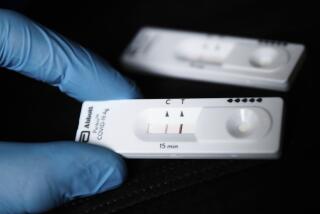Free Prostate Exams Help Detect Cancer
- Share via
It’s the most common cancer among American men and is second only to lung cancer as a killer of males. It can grow for years with no symptoms at all, and by the time typical symptoms do appear it may be too late to treat it successfully. An estimated 132,000 American men will get it this year, and 34,000 will die.
Yet many men typically ignore the risks and routinely shun the simple test that might save their lives.
Prostate cancer is the killer no one wants to talk about.
“Men are really more afraid to face the fact that they need a physical examination,” said John Davis, a Fullerton urologist and the chairman of the board of trustees of St. Jude Medical Center in Fullerton.
“Women are used to having a Pap smear from the time they’re 20, but men basically don’t go to doctors. It can be out of fear that the doctor might find something wrong, so they tend to put off going. It’s much easier to procrastinate than to do it.”
But various hospitals, clinics and private practitioners in the Los Angeles-Orange County area are trying to remove that excuse by offering free prostate exams through Oct. 11 as part of Prostate Cancer Awareness Week. According to the Prostate Cancer Education Council, more than a half-million Southern California men are expected to receive the exams, and another 120,000 are expected to undergo a second type of prostate cancer screening, the Prostate Specific Antigen blood test, at selected sites.
This is encouraging, Davis said, and indicates that men may be beginning to recognize the threat of prostate cancer in much the same way that women began taking the threat of breast cancer more seriously a decade ago.
“Prostate cancer has never had that kind of publicity,” Davis said. “But in the last couple of years, with (Sen. Robert) Dole and others of stature getting this disease, it’s getting talked about more.”
The people starting to do the talking are likely to be around 50, the age at which most doctors recommend that yearly prostate exams begin. (Yearly exams should be started at age 40 if there is a family history of prostate cancer, Davis said.)
In fact, more than half of all men over 50 develop a condition called benign prostatic hypertrophy, an enlargement of the prostate that can be benign or cancerous.
There often are no outward symptoms during the early stages of prostate cancer. Even though cancer may have invaded, the prostate--a walnut-sized gland at the base of the male bladder that produces semen--may function as if it were healthy.
During advanced stages of cancer, however, warning signs may include difficulty in urinating, frequent urination and the presence of blood in the urine or semen. Other symptoms may include fatigue, anemia, pain in the lower back, in the pelvis and in the upper thighs, weight loss and obstruction of the urinary tract.
About one in 11 men will develop prostate cancer. For unknown reasons, black American men have the highest incidence rate in the world: one in nine. The disease is rare in Asians, and the reason for this also is unknown, Davis said.
There are a handful of treatments for prostate cancer, depending on how far it has advanced.
Surgical removal of the gland or radiation treatments can cure the cancer in its early stages. The prostate can be radiated by an external source or through the use of tiny radiation “seeds” that are planted in the prostate itself.
Also, Davis said, it is possible to force the cancer into remission through the use of a process called hormonal manipulation. Because tumors in the prostate require the male hormone testosterone to grow, if production of that hormone is stopped through drug therapy, the growth of the cancer also may be stopped.
In its later stages, prostate cancer typically cannot be cured, but hormone therapy may retard its spread and help extend the patient’s life.
The good news: More than 80% of all patients whose tumors are diagnosed at an early stage are alive five years after treatment.
In fact, survival rates for all stages of the cancer have improved since 1940 and have increased nearly 25% in the past 20 years.
As with any cancer, Davis said, early detection is paramount, and the accuracy of the tests is improving.
The most common screening is the digital rectal exam, in which the doctor feels the prostate through the rectal wall to determine if it is enlarged or if a lump is present. The Prostate Specific Antigen blood test measures the possible rise of a protein in the blood that signals prostate cancer.
While the DRE alone is accurate about 23% of the time, the accuracy figure rises to 53% when coupled with the PSA test.
While the relatively new PSA test is available for a nominal charge at selected test sites in the Los Angeles-Orange County area (results of the test are being compiled as part of a study), many doctors have begun routinely to use the test in tandem with the DRE exam.
If the doctor suspects cancer, a third test, using a catheter that emits sound waves and produces an ultrasound “picture” of the prostate, may be ordered.
If the results of last year’s round of free screenings during Prostate Cancer Awareness Week are an indication, it pays to conquer fear or procrastination.
More than 400,000 men were tested in 1991 and, among the patients in which a diagnosis of cancer was confirmed, only 2.5% had advanced stage disease.
In the great majority, cancers were small and localized and more easily treatable. Which is good news--and well worth talking about.
For a listing of screening sites in your area, call the American Cancer Society at 1-(800) ACS-2345.






